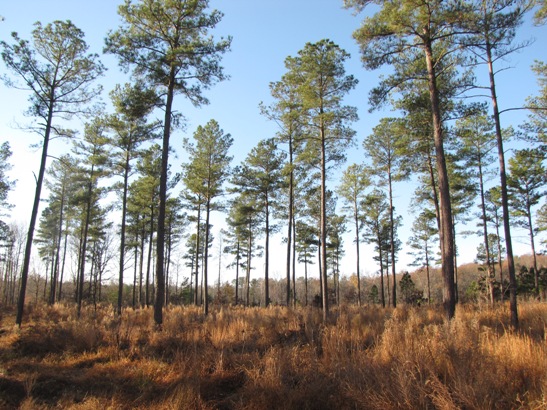Seeing the Light: a simple way to estimate
whether your timber stand is open enough for bobwhites
As biologists, foresters or other resource professionals, we tend to speak a language all our own. And it’s easy to forget most people we work with don’t speak that same language. I’m reminded of this every time I make a statement to a landowner like, “Your timber basal area is too high for quail. You have about 80 square feet of basal area per acre. With this age pine, you need that basal area down to about 40 to 50 square feet per acre to benefit quail.”
It took me a while to realize the blank stares I received back were not because of an overdose of cold medicine. In an

effort to make it simpler, I’d say something like, “Well, for trees of this age, a basal area of 40 to 50 square feet per acre would mean you would have about 50 to 60 trees per acre.” Huh? Thus, many a landowner has been forever lost to the babblings of a professional.
Let’s define basal area, then put it in context. Simply stated, basal area is the area in square feet of timber stumpage if you were to cut off every tree about 4 feet off the ground and measure the area of the stumps in square feet.

Envision a stand of older pine trees where each stump cut-off “at breast height” measured out at about 1 square foot of basal area. At this point in their growth, basal area and trees per acre would be exactly the same. To find the area of a circle, the equation A = π x R², or (R x R) where “R” equals the radius of the circle. If you do the math, what it boils down to is a tree that is about 13.5 inches in diameter produces 1 square foot of basal area. Let’s keep it simple and just say 14”. Thus if you had 60 trees of 14” diameter on an acre, you’d have about 60 square feet of basal area.
What a mess, eh? Clear as hot chocolate, right? My point, exactly.
But one thing should be obvious – it takes more trees per acre at smaller diameters to equal 1 square foot of basal area, and fewer larger trees. The good news is none of this math nonsense matters to a quail…what quail care about is how much sunlight reaches the forest floor at mid-day during summer. And it is not really the sunlight they care about. It is what the sunlight produces…more seed and insect-laden herbaceous growth down where they need it.
Let’s think about canopy closure, a concept I believe more people can relate to. Canopy closure ranges from 0% to 100%. A brand new cut-over has 0% canopy coverage. A triple canopy tropical rain forest has nearly 100% canopy coverage. So let’s forget about trees per acre and basal area and just keep it simple … think about sunlight reaching the forest floor. The general rule is this: “At mid-day during summer, when the sun is high in the sky, nearly directly overhead, a properly thinned stand of pines for quail will see about 60% – 65% sunlight on the forest floor at mid-day.” This translates roughly to 35% – 40% canopy coverage.
Simply put, when you stand under your thinned pine stand and look up, you should see a good bit more sky than tree crowns. This can be measured in many ways, one being with a densitometer. But understanding the concept is more important than taking exact measurements.
Most likely when you approach thinning your pines, you will work with a consulting forester. The forester will understand basal area and trees per acre. As the landowner, your job is to clearly state your goals to the forester. You need to make sure they understand you want to see your trees thinned a bit heavier than normal. The forester then translates your desires to the wood cutters.
Many cutters are accustomed to doing things a certain way. In order to communicate effectively how you want your trees thinned, it may be necessary to have a portion of the stand “marked.” The forester will use timber marking paint to mark “leave trees.” The cutter then harvests all but the un-marked trees. It costs money to have trees marked, but you do not have to have the entire stand done. For example, on our stand of loblolly pines, we had our forester mark five acres out of 65. These five acres gave the cutter a visual image of what we wanted and he took it from there. Our forester deducted the price of the marking out of our timber profits.
On most sites in Virginia loblolly pines are thinned first between the age of 15 and 20 years. We usually recommend that on a first thinning to simply go with the standard rate of thinning common in the area, or what your forester recommends. These younger trees are still relatively small in diameter and susceptible to wind and ice damage. But by the time they reach the age for a second thinning, 25 years or so, they can tolerate a real “quail thinning.” They can be managed from this point forward specifically for quail if that is your goal. While most loblolly pine stands are clear-cut for saw timber at around 35 years of age, there is no reason they cannot be managed much longer if the creation of pine savanna habitat is desired.
That’s enough for today. We’ll talk more next time about the economic pros and cons of longer term pine management, and we’ll throw in a discussion about prescribed fire to round out the discussion on what our friends at NBCI call “sunlight, fire and quail.”






